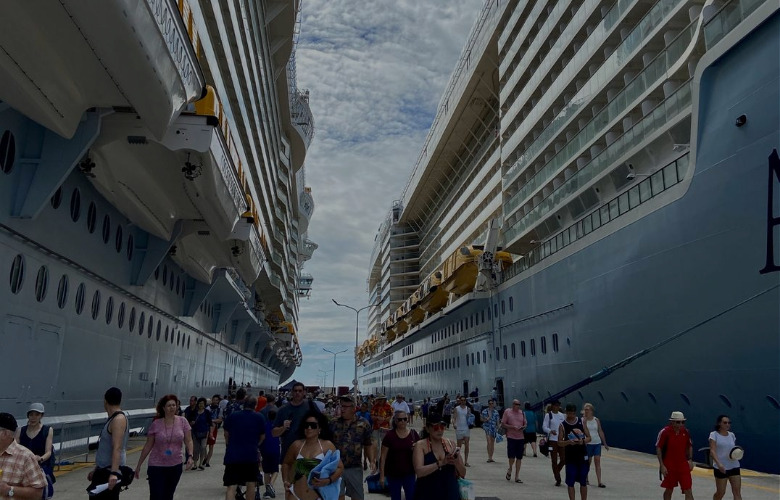
In the fall of 2019, I was offered a contract as Senior Stage & Production Manager on the Oasis of the Seas, one of the World’s largest cruise ships. After the first week, my predecessor left, as did the whole production team which had just finished the creation of our new show Aqua80. I received some last good advice, email addresses and phone numbers for emergencies, and was then left pretty much to my own devices.
It was my first time working on a cruise ship.
Taking over management of the aqua theater, or any theater, on a cruise ship gets easier the more contracts on ships you have done. Even if, like in my case, the handover is cut short and no handover notes exist.
Thus, for a regular theater onboard, the handover process to a manager already well versed in ship life is usually 2 weeks long. For aqua theaters, since they are technically more complex and hold a higher risk-factor, 4 weeks long.
In my case, well, it was going to take as long as it was going to take. I made my peace with not getting a proper handover and would teach myself as best as I could.
There was nothing I could do about the situation but take a very long deep breath whenever I needed to. I accepted the challenge and threw myself fully and enthusiastically into the daily operation of my venue.
Thankfully, many of the technicians had done multiple contracts in the Oasis aqua theater already. I wasn’t shy to ask them many questions. I invested a lot of time getting to know everyone in the team and listened to their needs and opinions.
Whenever they approached me with questions, I rather openly faced my dilemma of being completely new to both this venue and to ships by saying honestly, “I don’t know but I’ll find out for you as quickly as I can.”
Slowly, but surely, I realized that I knew more answers. The admin side of things was the easiest to learn. I was able to ask the other aqua theater stage and production managers on other ships. Or ask experienced people shoreside.
When it came to technical issues, I was lucky to have two incredibly capable engineers assigned to the aqua theater, Jack and Tomasz.
One thing I soon noticed was that I had three jobs rolled into one.
In any show on land the production manager and stage manager will be covered by two people. These are in fact two full-time jobs. On the Oasis of the Seas, I was stage and production manager, which already meant covering two separate sets of responsibilities.
Simply put, this made me responsible for absolutely everything pertaining to daily operations and maintenance of my venue.
On top of that, being a manager onboard also meant I was a two-and-a-half stripe officer. A rank which came with many additional responsibilities tied to ship safety. I was muster station leader during drills and emergencies. Emergency raft commander. I had to go to regular officer meetings. And I had to do cabin inspections as well as master inspections.
For my regular work day, this meant getting up at 8 am at the latest, since most drills and meetings began at 9 am.
Then, I was busy with officer duties and admin responsibilities until 1 or 2 pm. By this time, we usually started rehearsals, until 4 pm. On some days, the afternoons were instead filled with maintenance work on the theater pool and lifts.
Every day, we would start training and warm ups at around 5 pm until 7 pm. It was my duty to be present for every single moment our performers were in the venue.
After pre-set from 7 to 7:30 pm, I would make sure the house was ready and open.
Then, I would quickly run to the mess and grab a bite to eat. After, I would run straight back to the theater to check weather and sea conditions. Get the booth ready for the show. Call the captain, to see if he can do anything to help us with the rough seas.
And shortly before 8 pm, after speaking with the captain, the technical director, and the performers, I would decide if we would cancel that night’s show or go ahead.
It was winter. In the Caribbean this meant rough seas were the norm rather than the exception.
For the 10:30 pm show, I would be back again at 10 pm, check weather and sea conditions yet again, and go through the whole process once more of doing my utmost best to battle sea conditions and improve them with the help of the captain so our show could go ahead as planned.
After notes, I would need at least another two hours for show reports, maintenance problems, and admin.
At 1:30 am, I would usually walk slowly towards my cabin. Another day done safely and successfully. I would pour myself a glass of red wine, open a bag of chips and breathe deeply.
More often than not my ringing phone would interrupt my attempt to rest, until I would literally pass out, to be woken by either early phone calls or my alarm clock six hours later…
Read more about this intensive work and life experience in Part 4…
Don’t Wear That Hat: Theatre Superstitions & their Origins
Entertainment with A Splash: A History of Aquatic Shows


Liam Klenk was born in Central Europe and has since lived on four continents. Liam has always been engaged in creative pursuits, ranging from photography and graphic design, to writing short stories and poetry, to working in theatre and shows. In 2016, Liam published his first book and memoir, 'Paralian'.
Read Full Profile© 2021 TheatreArtLife. All rights reserved.

Thank you so much for reading, but you have now reached your free article limit for this month.
Our contributors are currently writing more articles for you to enjoy.
To keep reading, all you have to do is become a subscriber and then you can read unlimited articles anytime.
Your investment will help us continue to ignite connections across the globe in live entertainment and build this community for industry professionals.